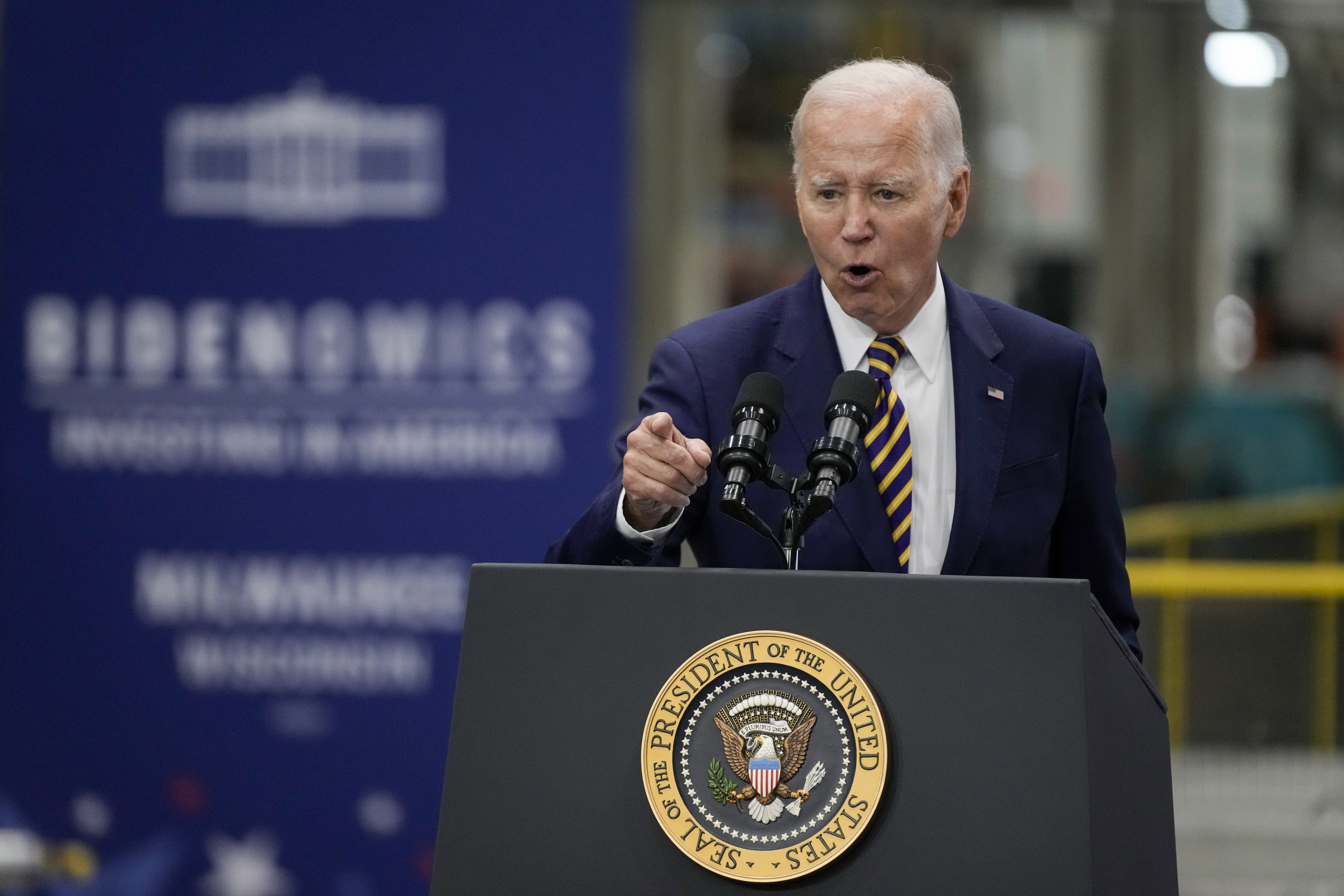
The Inflation Reduction Act that President Joe Biden signed into law one year ago Wednesday counts as his crowning legislative achievement: an economic stimulus package designed to put the U.S. at the forefront of the fight against climate change.
Polls show that Biden is struggling to get voters' attention for his signature law, and the anniversary is competing with headlines about record-high temperatures, deadly wildfires and other dire climate news from around the globe. But Biden and other Democrats have mostly leaned into an economic message as they fan out across the country to sell the public on the IRA, which has drawn at least $270 billion in private sector investments for technology such as wind turbines, solar panels and electric vehicle batteries.
The implications of the law are huge — with major questions remaining about its ultimate price tag, the swift transformation it’s pushing for the nation’s energy markets, and its ability to lessen the pollution that’s warming the planet.
Here are three big things to watch as the United States’ largest-ever climate law turns 1:
It’s proving more expensive than advertised
Estimates based on the Congressional Budget Office's official score last year put the cost of the law’s climate and energy provisions at about $391 billion over the decade between 2022 and 2031. But other analyses since then have put that figure much higher, including a Goldman Sachs estimate that said it would total closer to $1.2 trillion.
The increased figures are due in part to the fact that the law doesn’t cap many of its tax incentives and interest in taking advantage of those credits has been high. Analysts also cite implementation guidance coming out of the Treasury Department that has widened the variety of electric vehicles and other products that qualify for the law’s incentives.
White House senior adviser John Podesta suggested Wednesday those increased estimates indicate greater interest in the tax credits than initially anticipated last summer.
"That's a good news story. That means that people are investing in America," Podesta said. "They're putting people to work. We're bringing supply chains home. And overall in the mid- and long-term, this bill ... is reducing the deficit."
Republicans have seized on the newer estimates to accuse Democrats of downplaying the law's true cost, and to argue that wealthy individuals and big corporations will gain most of the benefits.
"The Inflation Reduction Act was a complete boondoggle," said Rep. Ralph Norman (R-S.C.). Rather than reduce inflation, he added, the law "was a giveaway to the leftwing agenda — the Green New Deal."
Douglas Holtz-Eakin, the president of the conservative American Action Forum and a former director of the Congressional Budget Office, said there’s “no question” the energy provisions will come at a bigger cost to the taxpayers than initially thought.
"You could have done just as much good cheaper,” he said, noting that the IRA provides subsidies for both power sources and for technologies — such as electric vehicles — that will use the power. "They're not coordinated in any way, so they can be really expensive in the end."
Supporters of the law’s energy provisions counter that the increasing estimates are proof that the IRA is working as intended to attract private sector investment and spur a transition to a clean energy.
"It’s generated more investment than even CBO anticipated," said Rep. Ro Khanna (D-Calif.). "It's really unlocked a tremendous amount of capital for battery plants, for electric vehicles, for clean hydrogen, for solar, for offshore wind."
One Credit Suisse estimate from earlier this year put total federal climate spending under the law at more than $800 billion, which in turn would spur $1.7 trillion in public and private spending over the next decade.
It’s super charging an energy transition
The U.S. has spent decades moving away from fossil fuels. That pace has sped up since the Inflation Reduction Act became law.
“I think you're going to look back at what's happening right now, in a few years, and everybody will know that this is an inflection point,” said Bob Keefe, executive director of the national clean energy business group E2. “This is a defining moment in the American economy that's going to change it forever.”
Supporters credit the fact that the law has locked in long-term incentives for both businesses and households to switch to cleaner energy — in place of a previous hodgepodge of tax breaks that used to phase out every few years.
The law includes 10-year expansions of key tax credits dating back to the 1990s and mid-2000s that have helped take the wind and solar power sectors from infancy to mature industries that are often cheaper than fossil fuels. Under the IRA, those credits evolved to allow a range of niche technologies such as clean hydrogen, battery storage and geothermal to qualify. Backers also see the law's shift to technology-neutral tax provisions tied to emissions reductions as transformational.
Senate Finance Chair Ron Wyden (D-Ore.) said Congress’ old recurring battles over wind and solar tax credits kept those industries mired in uncertainty. Now, he said in a statement, the IRA will "allow the free market to go to work — no picking winners and losers."
"It’s clear from the tidal wave of private investment going into clean energy manufacturing that there was enormous pent-up demand for a tax system that rewarded innovation and reduced emissions," Wyden said.
The nation’s solar power output is expected to be nearly 50 percent higher in a decade than it would have been without the IRA, according the Solar Energy Industries Association. Solar and wind power, along with the nascent energy storage sector, are projected to triple in size to contribute 40 percent of U.S. electricity by 2030.
The law also includes under-the-radar provisions intended to make the tax credits more accessible for entities such as nonprofits and Native American tribes, which previously struggled to tap into federal incentives that typically went to utilities and major power developers.
Those provisions alone could launch “a wave of new development,” said Gregory Wetstone, the president and CEO of the American Council on Renewable Energy, during an event this week.
The law is also making the U.S. an attractive market for international investment, with foreign companies making up nearly half of the more than 200 major new clean energy projects announced in the U.S. since Biden signed the IRA, according to a new report from E2.
Another fact with still-unknown political implications: An estimated 60 percent of clean energy investments triggered by the IRA are for projects in Republican-dominated states and congressional districts. Biden has acknowledged that not everyone in his party is happy about that.
“A lot of Democrats are getting mad at me because we're investing actually more in red states than blue states right now,” the president said Tuesday during an IRA-related appearance in Milwaukee. “But they're all Americans. I made a promise no matter where, and folks, red states, blue states, urban, suburban or rural — all of that will benefit from what we do."
Big decisions still loom
The law’s ultimate aim, of course, is to cut the United States’ vast contributions to planet-warming greenhouse gas pollution.
The Energy Department projects that the IRA, along with 2021's bipartisan infrastructure law, will have a large impact — causing U.S. greenhouse gas emissions to drop by up to 41 percent from 2005 levels by the end of this decade. That would make up a significant chunk of Biden's goal of cutting carbon emissions 50 to 52 percent by 2030.
But those goals depend on some major decisions that the administration has yet to announce in how it will disburse the IRA’s money.
Those include a new tax credit for hydrogen, a fuel that many experts view as critical to reducing greenhouse gas emissions from heavy industry.
The Treasury Department is developing accounting rules that will determine whether hydrogen makers must build new renewable energy sources to receive the tax credit. The existing hydrogen industry and business groups like the U.S. Chamber of Commerce oppose that requirement.
The administration is not expected to unveil initial guidance on the credit until the fall, missing a key deadline under the law.
Treasury also must issue closely-watched clarity on which electric vehicles could be left out of a consumer credit because of connections to China, as well as issue guidance for sustainable aviation fuel subsidies meant to reduce the greenhouse gas emissions from air travel.
Other groups hope to see the department clarify the rules it has already offered. For example, the department's initial guidance on the law's domestic content incentives, issued earlier this year, drew mixed reactions for not requiring the industry to use only U.S.-made materials for key solar panel components.
Items left out of the climate law have also drawn attention on and off Capitol Hill. Those include proposals to clear away obstacles to building clean energy infrastructure, particularly permitting for new power generation and expanding the power grid to accommodate it.
And the law's success depends on access to critical minerals such as lithium needed to build the vast number of batteries, wind turbines and solar panels the transition requires. The U.S. relies on imports for the vast majority of those materials, and growing competition as demand from around the world grows is expect to strain their supply — concerns laid out in a report earlier this week.
"There's a little bit of a 'dog caught car moment' for our sector, and we're delighted to be hanging on, but it's going to be quite a ride for the next several years," said Jason Grumet, the CEO of the American Clean Power Association.
Josh Siegel and Catherine Morehouse contributed to this report.







